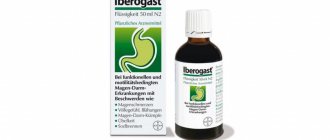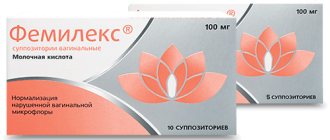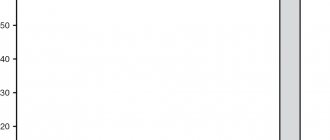According to research in our country, 15-35% of people experience allergic reactions[1]. Unfortunately, even small children are not immune from allergies. Due to imperfect immunity, the child’s body demonstrates an increased reaction to various substances.
There are enough allergens around the child. This includes food, dust, fur, and even animal secretions (for example, saliva). Allergic reactions are also provoked by plant pollen, chemical substances (washing powders, detergents), sunlight and medications. A child’s body may react inadequately to an insect bite and even to cold [2,3].
Pharmacological properties
Pharmacodynamics
A competitive histamine antagonist, a metabolite of hydroxyzine, blocks histamine H1 receptors. Prevents the development and facilitates the course of allergic reactions, has antipruritic and antiexudative effects. Affects the early stage of allergic reactions, limits the release of inflammatory mediators at the “late” stage of the allergic reaction, reduces the migration of eosinophils, neutrophils and basophils. Reduces capillary permeability, prevents the development of tissue edema, relieves spasm of smooth muscles.
Eliminates skin reactions to the introduction of histamine, specific allergens, as well as to cooling (with cold urticaria). Reduces histamine-induced bronchoconstriction in mild bronchial asthma.
It has virtually no anticholinergic and antiserotonin effects.
In therapeutic doses it practically does not cause a sedative effect. The onset of the effect after a single dose of 10 mg of cetirizine is 20 minutes, lasts more than 24 hours. During the course of treatment, tolerance to the antihistamine effect of cetirizine does not develop. After stopping treatment, the effect lasts up to 3 days.
Pharmacokinetics
Rapidly absorbed from the gastrointestinal tract, the time to reach maximum concentration (TCmax) after oral administration is about 1 hour. Food does not affect the completeness of absorption (AUC), but prolongs TCmax by 1 hour and reduces the maximum concentration (Cmax) by 23% . When taken at a dose of 10 mg once a day for 10 days, the equilibrium concentration of the drug (Css) in plasma is 310 ng/ml and is observed 0.5–1.5 hours after administration. Plasma protein binding is 93% and does not change with cetirizine concentrations in the range of 25–1000 ng/ml. The pharmacokinetic parameters of cetirizine change linearly when administered at a dose of 5–60 mg. Volume of distribution – 0.5 l/kg.
In small quantities, it is metabolized in the liver by O-dealkylation to form a pharmacologically inactive metabolite (unlike other H1-histamine receptor blockers, which are metabolized in the liver with the participation of the cytochrome P450 system). Cetirizine does not accumulate. About 2/3 of the drug is excreted unchanged by the kidneys and about 10% in the feces.
Systemic clearance – 53 ml/min. The half-life (T1/2) in adults is 10 hours, in children 6–12 years old – 6 hours, 2–6 years old – 5 hours, 0.5–2 years old – 3.1 hours. In elderly patients, T1/2 increases by 50%, systemic clearance is reduced by 40% (decreased renal function).
In patients with impaired renal function (creatinine clearance below 40 ml/min), drug clearance decreases and T1/2 lengthens (for example, in patients on hemodialysis, the total clearance decreases by 70% and is 0.3 ml/min/kg , and T1/2 is extended by 3 times), which requires a corresponding change in the dosage regimen. It is practically not removed during hemodialysis.
In patients with chronic liver diseases (hepatocellular, cholestatic or biliary cirrhosis), an increase in T1/2 by 50% and a decrease in total clearance by 40% are observed (adjustment of the dosage regimen is required only with a concomitant decrease in glomerular filtration rate). Passes into breast milk.
pharmachologic effect
Cetrin belongs to the group of antiallergic drugs. Its therapeutic activity is based on the suppression of type H1 histamine receptors.
The drug has an antipruritic, antiexudative effect. Helps reduce swelling, local hyperemia and other local symptoms.
Cetrin can be used for a wide range of diseases. For rhinitis, it helps relieve a runny nose, nasal congestion, suppresses sneezing, itching and excessive lacrimation.
A special therapeutic effect is observed at the initial stage of the pathology. In the late stage, a decrease in the production of mediators is recorded. When Cetrin interacts with allergens, there is a decrease in vascular permeability, tissue swelling and muscle spasms.
There is no antiserotonin and anticholinergic effect. When taking a daily dosage of no more than 25 mg, cognitive ability is not impaired.
After a long course of treatment, drug dependence does not develop.
The components of the product are quickly absorbed by the digestive tract, the maximum time for the pharmacological effect to occur is 1 hour.
Use during pregnancy and breastfeeding
Pregnancy
When analyzing prospective data on pregnancy outcomes, no cases of malformations, embryonic and neonatal toxicity with a clear cause-and-effect relationship were identified.
Animal studies have not revealed any direct or indirect adverse effects of cetirizine on the developing fetus (including in the postnatal period), pregnancy and childbirth.
There have been no controlled clinical studies on the safety of the drug during pregnancy, therefore cetirizine should not be used during pregnancy.
Breast-feeding
Cetirizine is excreted in breast milk in concentrations representing from 25% to 90% of the drug concentration in the blood plasma, depending on the time of administration. During breastfeeding, the drug is used after consultation with a doctor, if the expected benefit to the mother outweighs the potential risk to the child.
Fertility
Available data on the effects on human fertility are limited, but no adverse effects on fertility have been identified.
Why is Cetrin prescribed?
Regardless of the dosage form, Cetrin has general indications for use. Its use is relevant for the treatment of the following conditions:
- Rhinitis is chronic and seasonal.
- Allergic conjunctivitis.
- Hives.
- Quincke's edema.
- Dermatitis of allergic origin, characterized by intense itching.
- Bronchial asthma.
Directions for use and doses
Orally, regardless of food intake, without chewing, the tablets are taken with 200 ml of water.
Adults – 10 mg (1 tablet) 1 time a day or 5 mg (1/2 tablet) 2 times a day.
Children over 6 years old – 5 mg (1/2 tablet) 2 times a day or 10 mg (1 tablet) 1 time a day.
In patients with reduced renal function (creatinine clearance 30–49 ml/min), 5 mg/day (1/2 tablet) is prescribed, in severe chronic renal failure (creatinine clearance 10–30 ml/min) – 5 mg/day ( 1/2 tablet) every other day.
Side effects
Side effects when taking antihistamines do not occur often. Drowsiness and a feeling of dry mouth may occur. Less commonly noted:
- Severe headaches.
- Dizziness.
- Dyspeptic disorders.
- Migraine.
- Allergic reactions - itching, swelling, hyperemia, skin rashes. In severe cases, urticaria and angioedema develop.
Instructions for use of Cetrin
The treatment regimen for Cetrin differs depending on the dosage form. The dose and course of therapy are determined by the doctor based on the diagnosis and age of the patient.
The drug in tablet form is intended for oral administration. They are drunk at any time of the day before or after meals, washed down with the required amount of water.
Adult patients are prescribed 10 mg of the drug per day once or divided into 2 approaches.
In case of kidney disease, the dosage is calculated individually. As a rule, it is reduced by half. In particularly severe conditions, tablets are taken every other day.
The drug in the form of syrup is taken orally, regardless of food. Adults are recommended 10 ml per day. It is recommended to start treatment with 5 ml. For pronounced symptoms, it is permissible to increase the dose to 20 ml per day.
Elderly patients and patients with liver dysfunction do not require therapeutic dosage adjustment.
In case of kidney disease, the treatment regimen is reviewed.
Can Cetrin® be taken by children?
To treat allergies, you need an integrated approach, the basis of which is drug therapy and, as a rule, an antihistamine is always part of it. To select the right treatment, a special examination and a number of tests are usually carried out:
- Physical examination. It involves a thorough external examination of the child, identification of an allergic disease, and checking the condition of internal organs by palpation.
- A specific allergy examination involves passing provocative tests, analyzing a food diary, taking an anamnesis, as well as performing skin tests and laboratory examination methods.
- Laboratory methods (biochemical blood test, urine test, peripheral blood test, washings from the nasal cavity and conjunctiva of the eye, smears and cytological examination of secretions, sputum analysis, blood gas analysis, parasitological examination, etc.).
- Instrumental examination (bronchoscopy, rhinometry and anterior rhinoscopy).
A functional test or respiratory function test is carried out if bronchial asthma is suspected and bronchomotor tests are performed [5].
Cetrin® in the form of tablets can be used in children over 6 years of age, 5 mg (1/2 tablet) 2 times a day or 10 mg (1 tablet) 1 time a day. The drug is available in pharmacies without a doctor's prescription and is recommended for your home medicine cabinet in case you need to get rid of allergy symptoms.
How to take Cetrin®:
- Regardless of food intake.
- Take one tablet (10 mg) per day or 0.5 tablets (5 mg) twice a day with plenty of water.
- 3. If a side effect occurs, discontinue the drug.
Another reason for the popularity of the drug Cetrin® among parents is the low risk of side effects. The drug is a 2nd generation antihistamine and is well tolerated by children. Only in isolated cases may reactions occur from the central nervous system (drowsiness, dizziness, etc.), gastrointestinal tract (discomfort, dry mouth), allergic manifestations (rash, urticaria, itching, etc.).
For more detailed information about contraindications and side effects, please refer to the instructions for medical use.
Bibliography:
[1] Pariyskaya T.V. Allergy. Mom, I want to be healthy! / T. V. Pariyskaya. – M.: Eksmo, 2009. – 95 p.
[2] Dranik G.N., Clinical allergology and immunology: a manual for doctors / G.N. Dranik. – M.: Publishing house Medical Information Agency, 2003. – 604 p.
[3] Patterson R., Allergic diseases: diagnosis and treatment. / R. Patterson, L. K. Grammer, P. A. Greenberg; edited by A. G. Chuchalina. - M.: GEOTAR MEDICINE, 2000. - 768 p.
[4] National program “Bronchial asthma in children. Treatment strategy and prevention” / ed. ed. A. G. Chuchalina. – 3rd ed., revised. and additional - M.: Publishing House Atmosphere, 2008. - 108 p.
[5] Federal clinical recommendations for the diagnosis of allergic diseases // Russian organization of allergists and clinical immunologists (RAACI). – Moscow, 2015. – 9-12 p.
[6] Instructions for use of the medicinal product for medical use Cetrin®. – Registration number: P N013283/01.
[7] Cetrin® [Electronic resource] / Access mode: https://grls.rosminzdrav.ru / (Last access date 11/09/2017).
Manifestations and symptoms of allergies in children:
- Diathesis, atopic dermatitis. Accompanied by rashes.
- Hay fever. When pollen gets on the nasal mucosa, inflammation begins. The child sneezes, has difficulty breathing, and has nasal discharge.
- Allergic conjunctivitis. There is swelling of the eyelids and profuse lacrimation. Itching, photophobia, and a feeling of “sand” in the eyes may occur.
- Hives. Accompanies food and contact allergies. Skin rashes resemble mosquito bites or a nettle sting.
- Bronchial asthma is a particularly severe manifestation of allergies. Epidemiological studies in recent years confirm the high prevalence of asthma among children. It becomes difficult for the child to breathe, whistling and wheezing are heard, a debilitating cough appears, and attacks of suffocation are typical. The child gets tired quickly and has difficulty concentrating, complaining of drowsiness[4].
In a single manifestation, most symptoms do not pose a strong threat (with the exception of asthma attacks, Quincke's edema). It is enough to take the appropriate medicine. But it is necessary to take into account that reactions will appear constantly. General health may worsen each time. Over time, a negative reaction to the drug used in treatment occurs.
Allergies must be treated, but not every medicine is suitable for a child.






